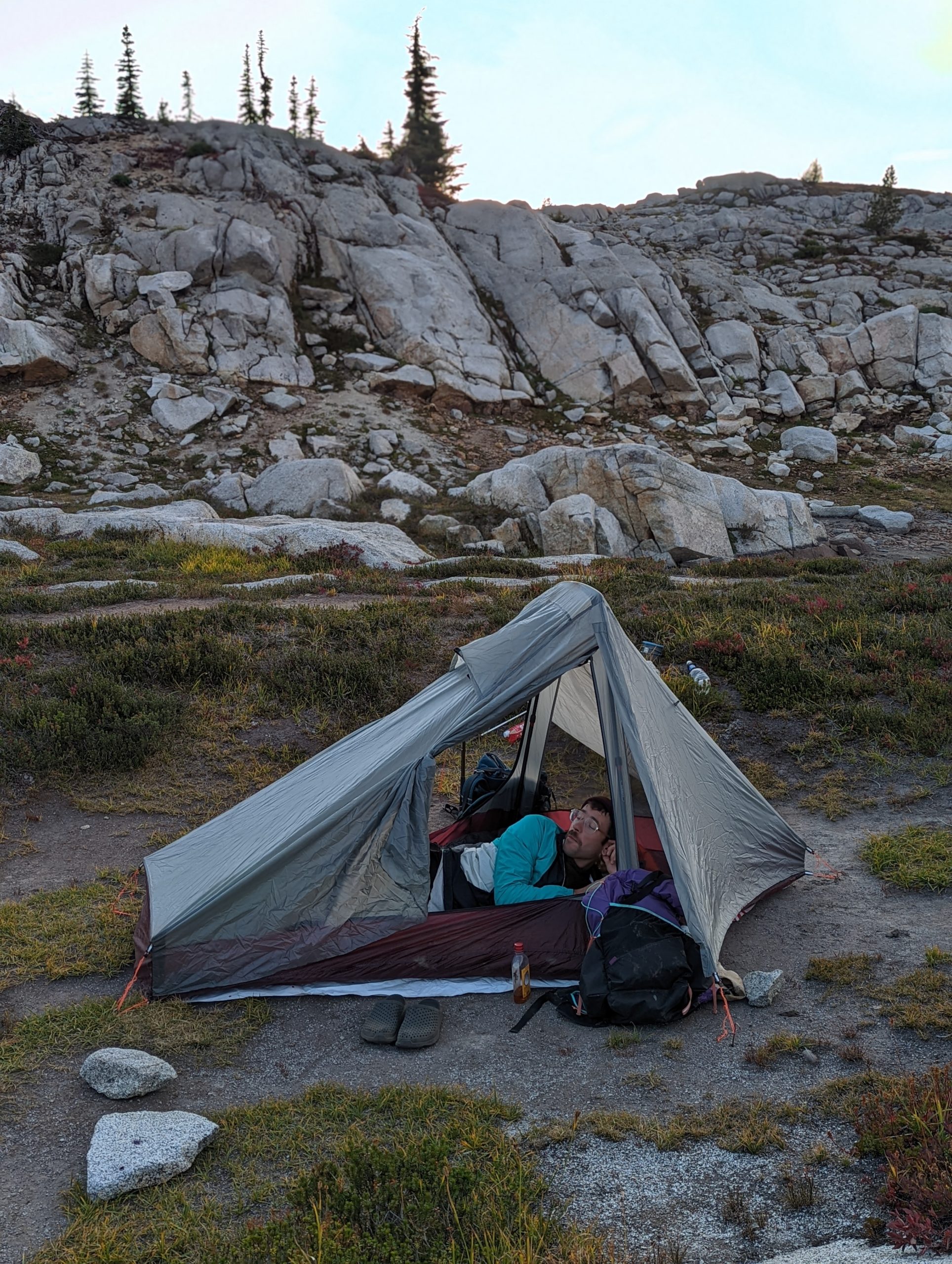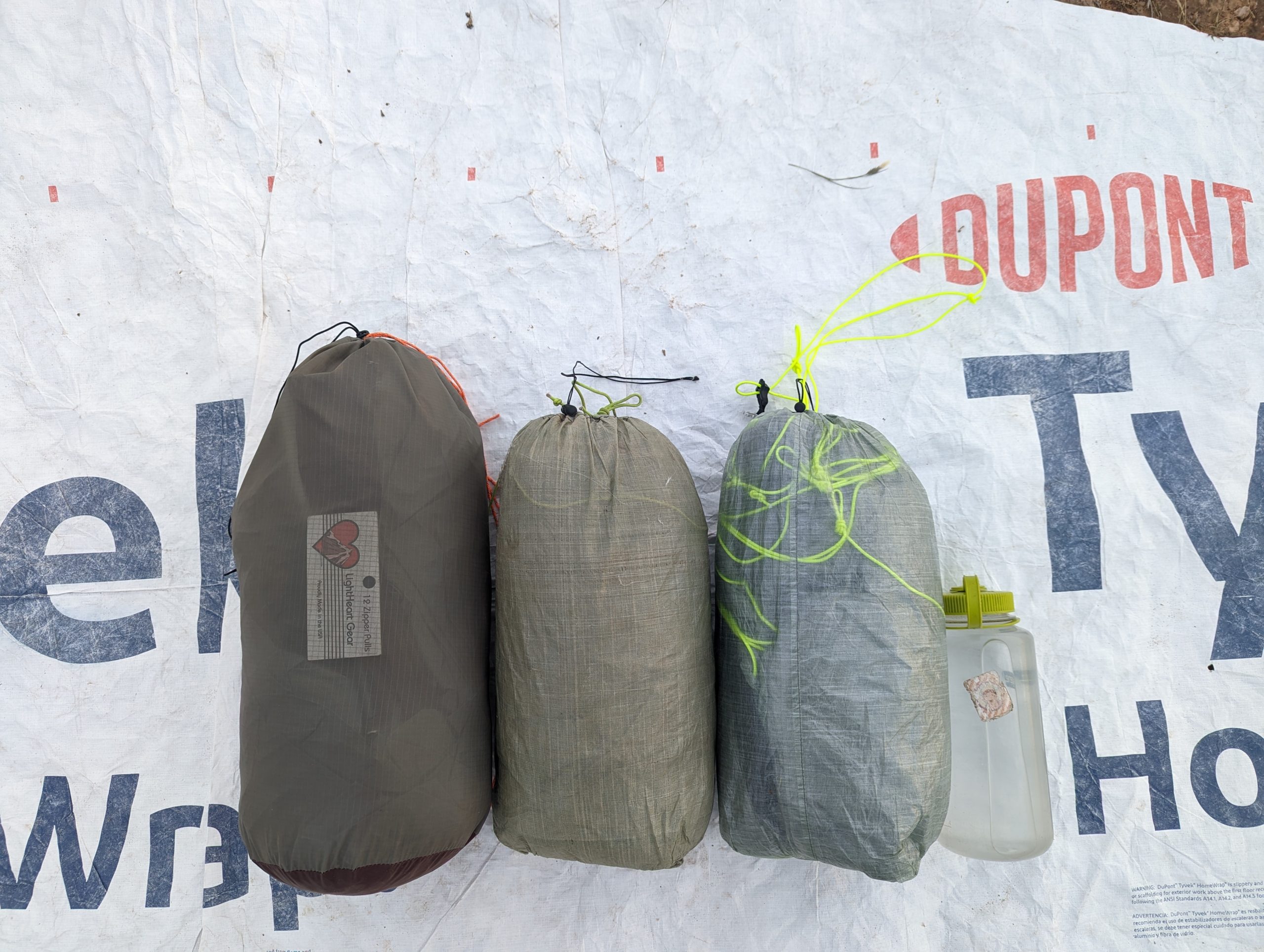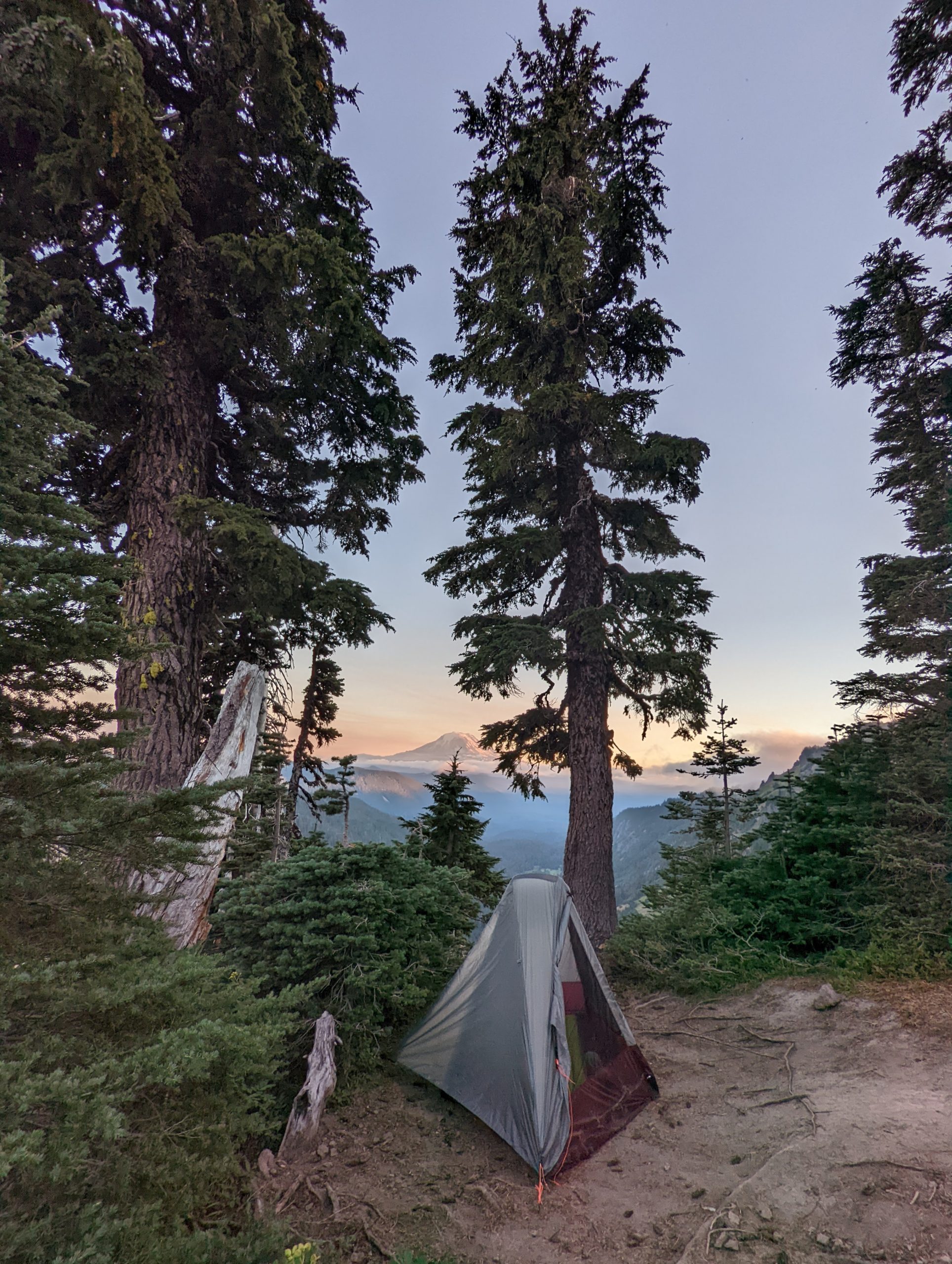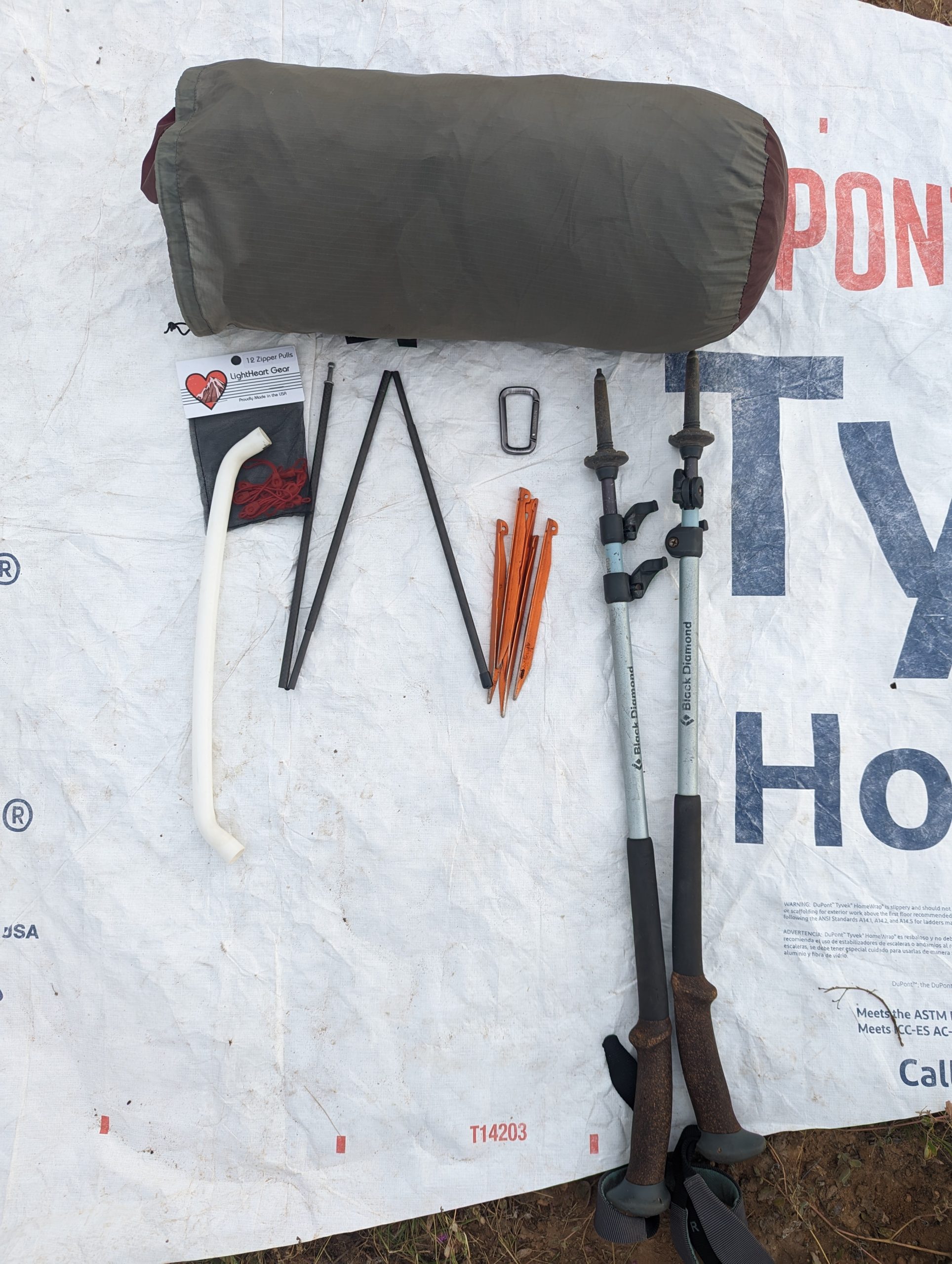LightHeart Gear FireFly 1-Person Trekking Pole Tent Review
At its core, the newest version of the LightHeart Gear FireFly tent trades simplicity for space. It requires a few extra pieces, as well as a few extra steps in setting up, but what you get in return is an extremely roomy tent for one person. In my opinion, it would also be a reasonable weight-saving option for two average-sized folks, although it would be fairly cramped.
Apart from this, with a bizarre—yet intriguingly versatile—awning, you also have a good amount of freedom in adjusting the tent to the type of weather you’re getting on trail. The FireFly performs equally well staked out in storms as it does when both doors are open on warm, starry nights.
Naturally, extra features like this come with a weight penalty. In this case, I don’t find the bells and whistles too excessive (more on this later). So, if you’re someone who is looking for a trekking pole tent with a bit more durability and versatility than budget options.

Really liking this form-fitting Tyvek groundsheet and how sweetly the sun bakes this thing on a 15-degree bluebird morning.
LightHeart Gear FireFly (Sil-Nylon version) At-a-Glance
MSRP: $315
- +$18 for a custom-cut Tyvek footprint
- +$38 for seam sealing service
Shelter Type: Non-freestanding, two trekking pole shelter
Weight: 29 ounces
Stakes Required: 5-7, depending on conditions
Materials: 30D ripstop nylon 66
Capacity: 1 large person with extra space or two average-sized people
Number of Doors: Two
Floor Size: Length: 105″ | Width: 55″/30″ (widest point/foot)
Peak Height: 45″
Bug + Water Protection: Excellent in both cases
Country of Origin: USA
The FireFly is also available in sil-poly.
A Little Bit About LightHeart Gear
LightHeart is a female and veteran-owned cottage gear company based out of North Carolina. They make sweet, innovative trekking pole tents along with various types of thru-hiking-oriented clothing—a lot of which is aimed towards women. Apart from this, you might recognize them for their microgrid fleeces, which have invited many alternative comparisons to the classic Melanzana fleece in the past.
One other thing worth mentioning that sometimes gets overlooked is that LightHeart has a very generous return and repair policy, which is aimed specifically toward thru-hikers.
Circumstance of Review
I’ve carried this tent on numerous multi-day trips all across the west. It’s probably got about 400 miles in my backpack and has been pitched about 20 nights, mostly in freezing or near-freezing temps. It held up equally well in fairly strong rain and winds.
Once you get the hang of pitching it, the setup is fairly quick and rudimentary. I’d say that multi-day trips are where this tent thrives—as it boasts more features than the higher-end, austerely ultralight options. But it’s also light enough that it won’t weigh you down over the course of a week or two.

Mini bottles of Fireball not included. Although if anyone is listening, I’ve got a business proposal.
LightHeart Gear FireFly Features
30D Ripstop Nylon: Ripstop is the same material used in Gossamer Gear’s The One, as well as some others like Durston, although 30D is a bit more industrious than GG’s thinner 10D fabric. The DCF that high-end companies like HMG and ZPacks use is much lighter than nylon, but it’s much more expensive. And the polyester that some companies like Six Moon Designs use is heavier but cheaper. So nylon is your middle-of-the-road option in terms of weight and price.
Side note: I find nylon to be somehow much quieter in the wind than DCF. So this tent scores bonus points on windy nights.
Vent Pole: For a slight weight penalty, you get much better circulation and ventilation in a tent that’s closed off for cold or inclement weather.
Ridge Pole Insert: For another weight penalty, there is a patented PEX pole you insert into the top of the tent to create more space and keep your trekking poles in place. It’s a clever feature. The reinforced material where the poles go means that there’s little danger of tearing the tent. The ridge pole fits inside the tent’s stuff sack.

The trekking poles fit slanted into the ridge pole to create more space. Two Z Lites fit snugly inside of it.
Two Doors: If you’re using this tent with another person, then having two doors is a must. And if not, then it’s nice to have that versatility when pitching in a tight space. It also provides more ventilation/views when both doors are open on nice nights.
Carbon Fiber Stays: Three small rods–one at the front and two bottom corners of the tent provide extra stability. Apart from this, they keep the bathtub elevated to protect it against splashback in a rain storm. They also help to maintain that space of mesh between the bathtub and tarp, which is critical for ventilation.
Optional Awning: This is an interesting feature that kind of takes an old staple of the Lunar Solo to the next level. A small carbon fiber pole adds a ton of extra vestibule space and gives you great ventilation even when you’ve closed everything else off.
Specially Cut Tyvek: For an extra $18, LightHeart will include a Tyvek sheet that accommodates the shape of the FireFly perfectly. That way, you don’t have to worry about water pooling under you, and you can keep the floor clean. Unless you’ve already got a Tyvek at home you can cut, I think this is worth the extra dollars since 18 bucks is barely more than it costs to just buy a sheet online and have it shipped.
READ NEXT – The Best Tents for Thru-Hiking

With the ridge pole and awning pole inside, this tent packs down flexibly to about the same size as a tight Zpacks Duplex or a loose Plex Solo. Nalgene for hydration and scale.
LightHeart Gear FireFly Pros
Spaciousness: This tent does a great job of utilizing every inch of space it creates. There’s room inside for two average-sized people and their packs or a ton of room for one person and their pack. And if you include the awning, then you’ll have even more space to explode your gear in every direction. Or have a great place for a furry friend or a bike to stay dry.
Ventilation: I’ve always been a bit precious when it comes to ventilation. I’ve pretty consistently taken points off reviews in the past for un-creative non-solutions to the problem of condensation, but I think that this tent does everything in its power to keep air flowing through it while retaining as much heat as possible. I like the small “stick” in the ridge vent, which you can Velcro open and closed. I think it achieves more ventilation than many other trekking pole shelters. And the same can be said for the stays at each end. Plus with the awning pitched, there is still plenty of air coming in underneath as well.
Durability: 30D ripstop nylon is strong enough that you can theoretically treat this tent a little harsher than some of its competitors, and it will withstand anything you can throw at it. I found this to be true. After adding the zipper pulls to the doors, I also find the zippers to be holding up well—a refreshing change, as the zippers are a problem area in many similar tents.
LightHeart Gear FireFly Cons
Weight: Coming in at 29 ounces before seam sealing (and without the awning pole or Tyvek), I think that this tent is just a little too heavy for what it’s offering. Yes, the features are generous, but are they gratuitous? I don’t know. How much space do you like? How much space do you truly need? Look deep into yourself.
Lots of Pieces: I’m a simple man of simplicity, simply put. And the fact is that, to experience this tent in all of its grandeur, you need to pack the ridge pole, the awning pole, seven stakes (though it can be pitched with five), and a carabiner in addition to the tent. Well, the carabiner can be clipped onto it permanently for another ounce. Either way, that’s a lot of pieces that can accidentally fall out or be left behind at the campsite. And the ridge pole is especially clunky and space-hogging in a backpack.
Missing a Pocket or Two: For all the features that the FireFly sports, I figured there would be an extra pocket or two inside for storage of smaller items. Instead, there is only one pocket to the left of the head. If you’re one person who doesn’t wear glasses or hang their headlamp overhead for sweet ambiance, this is probably sufficient. But sometimes I like to pretend I’m glamping.
Final Thoughts
Given the fact that this tent packs down to a very reasonable size (about the same as a Duplex or an Ultamid) it’s a totally viable option for any type of three-season hike you’re planning. You’ve got to ask yourself what you are looking for in a backpacking tent. A couple more bells and whistles? Extra features will give you more space and versatility, but they’ll cost you a couple of ounces in your pack. If that’s a trade-off you’re willing to make, then the Lightheart Gear FireFly is a great option for you.
The tent has an innovative design with a straightforward setup (once you get the hang of it). It can also be pitched on slopes and slants with a bit more flexibility than other trekking pole shelters. For the materials used and the manufacturing quality of this tent, I think it hits a very reasonable price point for the specialties it offers.
Shop the LightHeart Gear FireFly
Comparable Tents
MSRP: $699
Weight: 18.5 oz
MSRP: $250
Weight: 26 oz
MSRP: $299
Weight: 22.9 oz
The Lightheart Gear FireFly Tent was donated for purpose of review.
Corrections: The FireFly was originally described as a 1+ person tent; it is a 1p tent only. It requires a maximum of seven stakes to pitch, not nine as originally stated. The review originally mentioned that the pocket of the tent was partially sewn shut. This was a production error with the sample tested; the FireFly is normally sold with fully open pockets.
This website contains affiliate links, which means The Trek may receive a percentage of any product or service you purchase using the links in the articles or advertisements. The buyer pays the same price as they would otherwise, and your purchase helps to support The Trek's ongoing goal to serve you quality backpacking advice and information. Thanks for your support!
To learn more, please visit the About This Site page.

 ">
">




